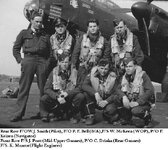I got a chuckle out of this! Dad did 7 ops on this aircraft.
Lancaster X KB.721 Weight data (wwiiaircraftperformance.org)
And here she is, photo by F/Lt HHM Cave.

Later the Nose-art changed. Brick Bradford was removed and a Rose painted on it instead. Here is a colour photo taken just before she was scrapped, Aylmer Ontario.
After dad flew her, she was flown by F/O J.W. Smith, who flew her back to Canada. He took the colour photo.
Jim

Lancaster X KB.721 Weight data (wwiiaircraftperformance.org)
And here she is, photo by F/Lt HHM Cave.
Later the Nose-art changed. Brick Bradford was removed and a Rose painted on it instead. Here is a colour photo taken just before she was scrapped, Aylmer Ontario.
After dad flew her, she was flown by F/O J.W. Smith, who flew her back to Canada. He took the colour photo.
Jim
Last edited:

